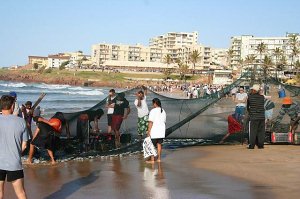Each year during June and July, huge shoals of sardines make their way north to the waters of KwaZulu Natal. Millions of sardines spawn in the cool waters of the Agulhas Bank and move northward to the warmer waters along South Africa’s east coast. It’s not unusual for shoals to be 7km long and 1.6km wide and to be clearly visible from the surface of the ocean.
The shoals draw thousands of sharks, dolphins and other predatory fish following the sardines, birds hovering above, and masses of people line the shores to watch.
Dolphins (estimated as being up to 18,000 in number) are largely responsible for rounding up the sardines into bait balls. These bait balls can be 10–20 metres in diameter and extend to a depth of 10 metres. The bait balls are short lived and seldom last longer than 10 minutes. Once the sardines are rounded up, sharks, game fish and birds take advantage of the opportunity.
In terms of biomass, researchers estimate the sardine run could rival East Africa’s great wildebeest migration. However, little is known of the phenomenon. It is believed that the water temperature has to drop below 21 °C in order for the migration to take place.
As the shoals draw nearer to shore, small commercial fishing boats set out through the surf, trailing their nets behind them. When a net fills with sardines, swimmers jump into the water and tie the ends to form a large bag. Timing is everything; if the shoal is very active, the fishermen know it’s being chased by sharks and the swimmers must wait.
The shoals sometimes become trapped and beach themselves. That’s when “sardine fever” really grips the crowd. People surge into the shallows, oblivious of the shark danger.
Jostling for space, they use buckets, hats, shirts, pants and every conceivable container as well as their bare hands to catch as much as they can.
For more information see the Sardine Festival or the South Coast Tourist Association.





